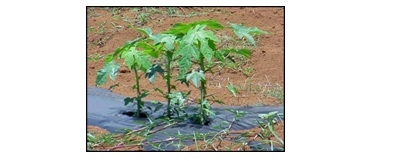Sowing:
------
About 250–300g seeds are sufficient for a hectare. The seedlings can be raised in nursery-beds 3m long, 1m wide and 10cm high as well as in pots or polythene bags. The seeds should be sown 1cm deep in rows 10cm apart and covered with fine compost or leaf-mould. Light watering should be done with watercan in the morning. The nursery-beds may be covered with polythene sheet or dry paddy straw to protect seedlings. Tender seedlings should also be protected from heavy rainfall. Dusting of insecticides to protect the seedlings against insect pests is also advised. Damping off is most serious disease. Treating seeds with 0.1% Monosan (phenyle mercury acetate), Ceresan, Agrosan or Thiram dust before sowing is the best preventive measure to check it. The nursery- beds should also be treated with 5% formaldehyde solution before sowing. If disease appears in the nursery, Bordeaux mixture (1%) or copper oxychloride (0.2%) should be sprayed.
The seedlings raised in polythene bags stand transplanting better than those raised in seed-beds. Perforated polythene bags of 20cm × 15cm size of 150–200 gauge can be used as a container. They are filled with a mixture of farmyard manure, soil and sand in equal proportion. Four to five seeds are sown in each bag. After germination only three seedlings are retained.
The seedlings may be transferred to nursery-beds or pots or polythene bags to avoid overcrowding and further check of growth of. This is also done when the field is not ready for planting. Generally 15–20cm tall seedlings become ready for planting in about two months.
Field preparation:
------
• Since papaya does not withstand water logging, a well-drained upland should be selected for its cultivation. Its plants are also sensitive to strong winds. In open and high-lying areas, where plants are exposed to strong winds or storm, suitable windbreaks are essential to protect them. Such windbreaks also save the trees to a great extent from damage caused by cold winds or frost.
• The seedlings are planted in pits of 60cm × 60cm × 60cm size. The pits are dug about 15 days before in summer and filled with top soil along with 20kg farmyard manure, 1kg neem or karanj cake and 1kg bone-meal or fish-meal. Tall and vigorous varieties are planted at greater spacing, while medium and dwarf ones at closer spacing.
Planting:
------
Papaya is planted during spring (February–March), monsoon (June–July) and autumn (October–November). Spring planting is done in areas where the climatic condition is mild throughout the year. Monsoon planting is preferred in the frost-prone areas, and autumn planting generally done in the regions where the rainfall is high and virus problem is acute in rainy season. Plants are protected against frost damage by covering them with a polythene-sheet.
Planting distance is determined by the integration of light interception, cultivar and economic consideration. A spacing of 1.8m × 1.8m is normally followed for most of the cultivars. A closer spacing of 1.33m × 1.33m (5,609 plants/ha) is optimum for variety Coorg Honey Dew. The spacing of 1.4m × 1.4m or 1.4m × 1.6m is best-suited for papaya Pusa Delicious under subtropical condition of Bihar. Spacing of 1.6m × 1.6m gives highest yield of fruits as well as papain in Tamil Nadu. A closer spacing of 1.2m × 1.2m for Pusa Nanha is adopted for high-density orcharding, accommodating 6,400 plants/ha.
Integration of light interception, cultivar and economic consideration. A spacing of 1.8m × 1.8m is normally Planting distance is determined by the followed for most of the cultivars. A closer spacing of 1.33m × 1.33m (5,609 plants/ha) is optimum for variety Coorg Honey Dew. The spacing of 1.4m × 1.4m or 1.4m × 1.6m is best-suited for papaya Pusa Delicious under subtropical condition of Bihar. Spacing of 1.6m × 1.6m gives highest yield of fruits as well as papain in Tamil Nadu. A closer spacing of 1.2m × 1.2m for Pusa Nanha is adopted for high-density orcharding, accommodating 6,400 plants/ha.
Aftercare:
------
Proper care should be taken to save the seedlings in the field especially against insect pests and heavy rainfall in early stage. In frost-prone areas, they should be protected with small thatches or polythene structure. Some extra seedlings reserved in the nursery may be utilized for gap filling.
Since sufficient space is available between rows, papaya-based cropping systems (sequential and intercropping) are most remunerative. Papaya + tobacco intercropping in north Bihar is ideal. It is advised not to grow crops like chilli, tomato, brinjal and lady’s finger to avoid viruses as they act like host.
No intercrop should be taken when flowering and fruiting start. A suitable crop rotation must be followed to maintain soil fertility and to avoid replant problem. Intercropping leguminous crops after non-leguminous ones, shallow-rooted crops after deep rooted ones are beneficial


